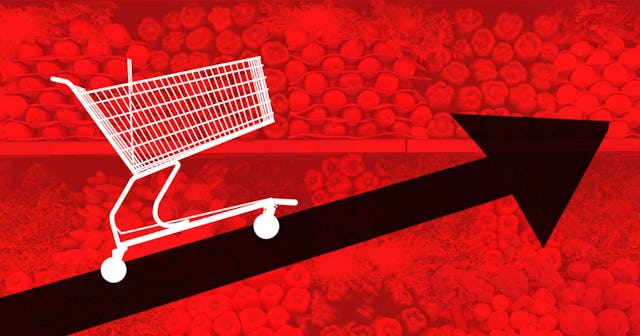It's Not Your Imagination — Groceries Really Are Getting More Expensive

Have you noticed your grocery bills have been higher lately? Does the cost of feeding your brood cause you concern? If so, you’re not alone. From milk, bread, eggs, and yogurt to Coca-Cola and Lunchables, there has been a marked increase in the market. According to the Bureau of Labor Statistics, consumer prices have increased 5% since May 2020. That’s 5% in 16 short months. And while numerous factors have contributed to rising costs — from general shortages and inflation to supply and demand — the biggest issue is “supply chain distribution,” or the way in which companies get and/or acquire their products. Because thanks to COVID-19, there is a kink in the system. Bottlenecks abound.
“Food producers have struggled with shortages, bottlenecks, and transportation, weather and labor woes, all of which have caused food prices to rise,” an article on The Washington Post explains. Protocols meant to keep workers safe shut down entire segments of the distribution chain, and shipping delays persist — particularly with international goods. It is hard to keep store shelves stocked, particularly with high-demand products.
“Ingredient supplies [are] see[ing] longer lead times because of lack of staffing, ingredient shortages, and the unpredictability of trucking and container ship transport,” the article continues. “In many cases, those lead times have dragged out eight to 12 weeks, with food manufacturers stalled out waiting for ingredients for their products.”
Climate change is also impacting agricultural output, with droughts, frost, fires, and unsteady rains disrupting growing seasons.
“Climate change is greatly affecting the foods that we grow and how we grow them,” Phil Lempert, an analyst and food trends expert known as the Supermarket Guru, recently told Fortune. “Long term, we will see a lot more indoor farming, but that takes hundreds of millions of dollars and time to build.” In the interim, prices will go up.
industryview/Getty
Of course, it’s not just grocery stores taking a hit. Food purveyors of all kinds have been affected by supply chain issues and inflation. Sysco, for example — one of the nation’s biggest distributors of wholesale food — revealed their products increased more than 10% in a recent quarterly report and that increase was passed along to restaurateurs which, in turn, was passed on to consumers. That means you’re paying more to dine out (or in).
“Increases are also being reflected in prices you’ll pay dining out,” GoBanking explains. “In restaurants or take-out.”
And some products have been more affected than others. According to a recent article by Business Insider, the dairy industry has taken a big hit, with the cost of cheese, milk, and ice cream rising. Coffee prices are at a six-year high, though this is due to a cold snap in Brazil and not COVID-19, and household products remain in-demand.
GoBanking also reports bread, olives, salami, rose wine, and craft beer have all increased markedly.
The good news is these increases will likely be temporary, or — at the the very least — they will slow or stall out. However, Lempert told Fortune we should expect these increases to continue, at least for some time. “We’re going to continue to see price increases, probably for the next two years or so,” Lempert said. And Jayson Lusk, the head of the department of agricultural economics at Purdue University, agrees.
“We had a big jump up [at the beginning of the pandemic] and then sort of slow and steady increases,” Lusk told Fortune. But numbers will continue to rise. The cost of food is on an upward trajectory, one which will continue for the next few years.
In the interim, there are things you can do to save money and lower your grocery bill. Keep track of your spending, if you don’t already. Take inventory of what you have. Knowing what is in your cupboards and fridge will reduce the likelihood you will make an impulse purchase. It will also prevent you from buying more than you can consume. Meal plan whenever possible. This can be done on a weekly basis and will help minimize waste. You also can and should clip coupons, read circulars, and comparison shop. Buying in bulk is a great way to save, if you can store the items for use at a later date. Just be sure to avoid hoarding, as this can cause supply issues and increase a product’s overall demand.
I’m looking at you, Toilet Paper Trina.
This article was originally published on